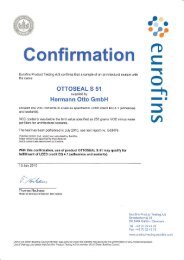Sikaflex-1A Plus - Sika UK
Sikaflex-1A Plus - Sika UK
Sikaflex-1A Plus - Sika UK
You also want an ePaper? Increase the reach of your titles
YUMPU automatically turns print PDFs into web optimized ePapers that Google loves.
Safety Data Sheet<br />
Conforms to Regulation (EC) No. 1907/2006 (REACH), Annex II - United Kingdom (<strong>UK</strong>)<br />
1.<br />
IDENTIFICATION OF THE SUBSTANCE/PREPARATION AND OF<br />
THE COMPANY/UNDERTAKING<br />
Identification of the substance/preparation<br />
Product name or Trade name :<br />
<strong><strong>Sika</strong>flex</strong>-<strong>1A</strong> <strong>Plus</strong><br />
Use of the substance/preparation<br />
Company/undertaking identification<br />
:<br />
Chemical product for construction and industry<br />
Manufacturer/Distributor<br />
Telephone no.<br />
: 01707 394444<br />
Fax no. : 01707 329129<br />
e-mail address of person<br />
responsible for this SDS<br />
Emergency telephone number<br />
:<br />
:<br />
:<br />
<strong>Sika</strong> Limited<br />
Watchmead Welwyn Garden City<br />
Hertfordshire. AL7 1BQ<br />
United Kingdom<br />
EHS@uk.sika.com<br />
+44 (0)1707 363899 (available during office hours).<br />
2.<br />
HAZARDS IDENTIFICATION<br />
The product is not classified as dangerous according to Directive 1999/45/EC and its amendments.<br />
Additional warning phrases : Contains isocyanates. See information supplied by the manufacturer. Contains 3-<br />
isocyanatomethyl-3,5,5-trimethylcyclohexyl isocyanate. May produce an allergic<br />
reaction. Safety data sheet available for professional user on request.<br />
See section 11 for more detailed information on health effects and symptoms.<br />
3.<br />
COMPOSITION/INFORMATION ON INGREDIENTS<br />
Chemical family/<br />
Characteristics<br />
:<br />
Filled, reactive PUR-polymers<br />
Ingredient name CAS number % EC number Classification<br />
Naphtha (petroleum), hydrodesulfurized heavy 64742-82-1
<strong><strong>Sika</strong>flex</strong>-<strong>1A</strong> <strong>Plus</strong> 24.11.2010 2/5<br />
4.<br />
FIRST AID MEASURES<br />
First-aid measures<br />
Inhalation<br />
Ingestion<br />
Skin contact<br />
Eye contact<br />
Notes to physician<br />
:<br />
:<br />
:<br />
:<br />
:<br />
Get medical attention if symptoms occur.<br />
Do not induce vomiting unless directed to do so by medical personnel. Maintain an<br />
open airway. Seek immediate medical attention.<br />
Flush contaminated skin with plenty of water. Remove contaminated clothing and<br />
shoes. Get medical attention if symptoms occur.<br />
Immediately flush eyes with plenty of water, occasionally lifting the upper and lower<br />
eyelids. Check for and remove any contact lenses. Continue to rinse for at least 10<br />
minutes. Get medical attention.<br />
No specific treatment. Treat symptomatically. Contact poison treatment specialist<br />
immediately if large quantities have been ingested or inhaled.<br />
See section 11 for more detailed information on health effects and symptoms.<br />
5.<br />
FIRE-FIGHTING MEASURES<br />
Extinguishing media<br />
Suitable : Use an extinguishing agent suitable for the surrounding fire.<br />
Not suitable : None known.<br />
Special exposure hazards : In a fire or if heated, a pressure increase will occur and the container may burst.<br />
Hazardous combustion<br />
products<br />
Special protective<br />
equipment for fire-fighters<br />
:<br />
:<br />
Decomposition products may include the following materials:<br />
carbon dioxide<br />
carbon monoxide<br />
halogenated compounds<br />
metal oxide/oxides<br />
Fire-fighters should wear appropriate protective equipment and self-contained<br />
breathing apparatus (SCBA) with a full face-piece operated in positive pressure<br />
mode.<br />
6. ACCIDENTAL RELEASE MEASURES<br />
Personal precautions<br />
Environmental precautions<br />
Large spill :<br />
Small spill :<br />
: Keep unnecessary and unprotected personnel from entering. Do not touch or walk<br />
through spilt material. Put on appropriate personal protective equipment (see section<br />
8).<br />
:<br />
Avoid dispersal of spilt material and runoff and contact with soil, waterways, drains<br />
and sewers. Inform the relevant authorities if the product has caused environmental<br />
pollution (sewers, waterways, soil or air).<br />
Stop leak if without risk. Move containers from spill area. Prevent entry into sewers,<br />
water courses, basements or confined areas. Contain and collect spillage with noncombustible,<br />
absorbent material e.g. sand, earth, vermiculite or diatomaceous earth<br />
and place in container for disposal according to local regulations (see section 13).<br />
Stop leak if without risk. Move containers from spill area. Absorb with an inert<br />
material and place in an appropriate waste disposal container.<br />
7.<br />
HANDLING AND STORAGE<br />
Handling<br />
Storage<br />
Packaging materials<br />
:<br />
:<br />
Put on appropriate personal protective equipment (see section 8). Eating, drinking<br />
and smoking should be prohibited in areas where this material is handled, stored and<br />
processed. Workers should wash hands and face before eating, drinking and<br />
smoking. Avoid contact with eyes, skin and clothing. Keep in the original container or<br />
an approved alternative made from a compatible material, kept tightly closed when<br />
not in use.<br />
Store in accordance with local regulations. Store in original container protected from<br />
direct sunlight in a dry, cool and well-ventilated area, away from incompatible<br />
materials (see section 10) and food and drink. Keep container tightly closed and<br />
sealed until ready for use. Containers that have been opened must be carefully<br />
resealed and kept upright to prevent leakage. Do not store in unlabelled containers.<br />
Use appropriate containment to avoid environmental contamination.<br />
Date of issue : 24.11.2010.<br />
MSDS no. : 33408<br />
2/5
<strong><strong>Sika</strong>flex</strong>-<strong>1A</strong> <strong>Plus</strong> 24.11.2010 3/5<br />
7.<br />
HANDLING AND STORAGE<br />
Recommended<br />
: Use original container.<br />
8. EXPOSURE CONTROLS/PERSONAL PROTECTION<br />
Exposure limit values<br />
Ingredient name<br />
No exposure limit value known.<br />
Occupational exposure limits<br />
Recommended monitoring<br />
procedures<br />
Exposure controls<br />
Occupational exposure<br />
controls<br />
Hygiene measures :<br />
Respiratory protection :<br />
Hand protection<br />
Eye protection<br />
Skin protection<br />
Environmental exposure<br />
controls<br />
:<br />
If this product contains ingredients with exposure limits, personal, workplace<br />
atmosphere or biological monitoring may be required to determine the effectiveness<br />
of the ventilation or other control measures and/or the necessity to use respiratory<br />
protective equipment. Reference should be made to European Standard EN 689 for<br />
methods for the assessment of exposure by inhalation to chemical agents and<br />
national guidance documents for methods for the determination of hazardous<br />
substances.<br />
: Good general ventilation should be sufficient to control worker exposure to airborne<br />
contaminants. If this product contains ingredients with exposure limits, use process<br />
enclosures, local exhaust ventilation or other engineering controls to keep worker<br />
exposure below any recommended or statutory limits.<br />
:<br />
:<br />
Wash hands, forearms and face thoroughly after handling chemical products, before<br />
eating, smoking and using the lavatory and at the end of the working period.<br />
Appropriate techniques should be used to remove potentially contaminated clothing.<br />
Wash contaminated clothing before reusing.<br />
No special measures required.<br />
Chemical-resistant, impervious gloves complying with an approved standard should<br />
be worn at all times when handling chemical products if a risk assessment indicates<br />
this is necessary. Recommended: Butyl rubber/nitrile rubber gloves.<br />
Safety eyewear complying with an approved standard should be used when a risk<br />
assessment indicates this is necessary to avoid exposure to liquid splashes, mists,<br />
gases or dusts.<br />
Personal protective equipment for the body should be selected based on the task<br />
being performed and the risks involved and should be approved by a specialist before<br />
handling this product. Recommended: Use barrier skin cream.<br />
: Emissions from ventilation or work process equipment should be checked to ensure<br />
they comply with the requirements of environmental protection legislation. In some<br />
cases, fume scrubbers, filters or engineering modifications to the process equipment<br />
will be necessary to reduce emissions to acceptable levels.<br />
9.<br />
PHYSICAL AND CHEMICAL PROPERTIES<br />
General information<br />
Appearance<br />
Form<br />
Colour<br />
Odour<br />
:<br />
:<br />
:<br />
Paste.<br />
Various.<br />
Characteristic.<br />
Important health, safety and environmental information<br />
Flash point<br />
: Closed cup: >100°C (>212°F)<br />
Density<br />
: ~1.24 g/cm 3 [20°C (68°F)]<br />
Solubility<br />
: Insoluble in the following materials: water<br />
Viscosity<br />
: Dynamic: 100000 mPa·s (100000 cP)<br />
Date of issue : 24.11.2010.<br />
MSDS no. : 33408<br />
3/5
<strong><strong>Sika</strong>flex</strong>-<strong>1A</strong> <strong>Plus</strong> 24.11.2010 4/5<br />
10.<br />
STABILITY AND REACTIVITY<br />
Stability<br />
Conditions to avoid<br />
Materials to avoid :<br />
Hazardous decomposition<br />
products<br />
:<br />
:<br />
:<br />
The product is stable.<br />
No specific data.<br />
No specific data.<br />
Under normal conditions of storage and use, hazardous decomposition products<br />
should not be produced.<br />
11.<br />
TOXICOLOGICAL INFORMATION<br />
Potential acute health effects<br />
Inhalation<br />
: May cause irritation.<br />
Ingestion<br />
: Can cause gastrointestinal disturbances.<br />
Skin contact<br />
: May cause skin irritation.<br />
Eye contact<br />
: May cause eye irritation.<br />
Chronic effects : No known significant effects or critical hazards.<br />
12.<br />
ECOLOGICAL INFORMATION<br />
Environmental effects<br />
: Avoid contact of spilt material and runoff with soil and surface waterways. Do not<br />
empty into drains; dispose of this material and its container in a safe way.<br />
13.<br />
DISPOSAL CONSIDERATIONS<br />
Methods of disposal<br />
European waste catalogue<br />
(EWC)<br />
:<br />
:<br />
The generation of waste should be avoided or minimised wherever possible. Empty<br />
containers or liners may retain some product residues. This material and its container<br />
must be disposed of in a safe way. Dispose of surplus and non-recyclable products<br />
via a licensed waste disposal contractor. Disposal of this product, solutions and any<br />
by-products should at all times comply with the requirements of environmental<br />
protection and waste disposal legislation and any regional local authority<br />
requirements. Avoid dispersal of spilt material and runoff and contact with soil,<br />
waterways, drains and sewers.<br />
08 04 10 waste adhesives and sealants other than those mentioned in 08 04 09<br />
Packaging<br />
: Completely emptied packaging or practically empty packaging containing dried/cured<br />
residues, once relieved of all pressure can be disposed of as non-hazardous waste.<br />
Packaging may still contain hazardous residues and disposal should undertaken by a<br />
licensed waste contractor.<br />
Any disposal practice must be in compliance with local and national laws and<br />
regulations.<br />
14.<br />
TRANSPORT INFORMATION<br />
International transport regulations<br />
ADR<br />
Not regulated.<br />
IMDG<br />
Not regulated.<br />
Marine pollutant<br />
IATA<br />
Not regulated.<br />
:<br />
No<br />
Date of issue : 24.11.2010.<br />
MSDS no. : 33408<br />
4/5
<strong><strong>Sika</strong>flex</strong>-<strong>1A</strong> <strong>Plus</strong> 24.11.2010 5/5<br />
15.<br />
REGULATORY INFORMATION<br />
EU regulations<br />
Classification and labeling have been determined according to EU Directives 67/548/EEC and 1999/45/EC<br />
(including amendments) and take into account the intended product use.<br />
Classification : This product is not classified according to EU legislation.<br />
Additional warning phrases : Contains isocyanates. See information supplied by the manufacturer. Contains 3-<br />
isocyanatomethyl-3,5,5-trimethylcyclohexyl isocyanate. May produce an allergic<br />
reaction. Safety data sheet available for professional user on request.<br />
VOC content (EU) : VOC (w/w): 1.36%<br />
National regulations<br />
Regulatory information<br />
Guidance Publications<br />
:<br />
Chemicals (Hazard Information and Packaging for Supply) Regulations 2009 (CHIP<br />
4)<br />
Control of Substances Hazardous to Health Regulations 2002 (COSHH) (as<br />
amended)<br />
Health & Safety at Work Act 1974<br />
The Environmental Protection (Duty of Care) Regulations 1991<br />
The Carriage of Dangerous Goods and Use of Transportable Pressure Equipment<br />
Regulations 2007<br />
: Approved Code of Practice - Management of Health and Safety at Work, HSE<br />
General Approved Code of Practice to COSHH Regulations, HSE.<br />
16.<br />
OTHER INFORMATION<br />
Full text of classifications<br />
referred to in sections 2 and<br />
3<br />
Full text of classifications<br />
referred to in sections 2 and<br />
3<br />
:<br />
:<br />
R10- Flammable.<br />
R65- Harmful: may cause lung damage if swallowed.<br />
R66- Repeated exposure may cause skin dryness or cracking.<br />
R67- Vapours may cause drowsiness and dizziness.<br />
R51/53- Toxic to aquatic organisms, may cause long-term adverse effects in the<br />
aquatic environment.<br />
Xn - Harmful<br />
N - Dangerous for the environment<br />
History<br />
Date of printing<br />
24.11.2010.<br />
Date of issue : 24.11.2010.<br />
Date of previous issue : No previous validation.<br />
Notice to reader<br />
:<br />
Indicates information that has changed from previously issued version.<br />
The information contained in this Safety Data Sheet corresponds to our level of knowledge at the time of<br />
publication. All warranties are excluded. Our most current General Sales Conditions shall apply. Please consult<br />
the product data sheet prior to any use and processing.<br />
Date of issue : 24.11.2010.<br />
MSDS no. : 33408<br />
5/5


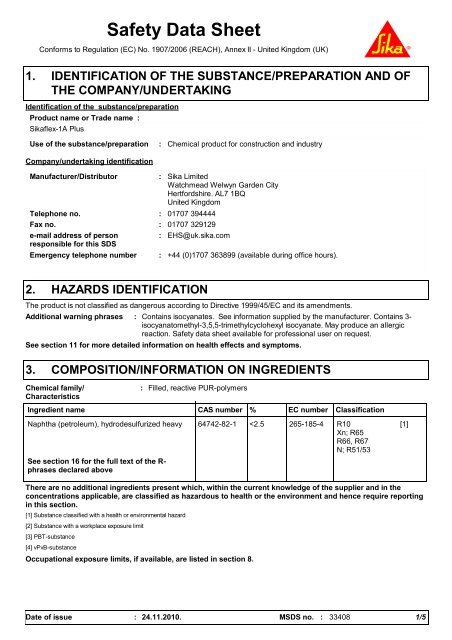
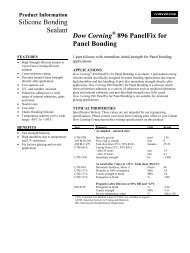
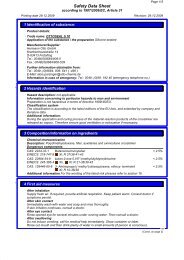
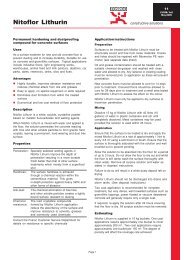
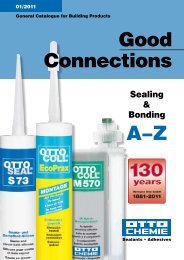
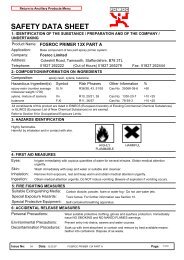


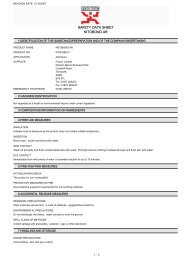

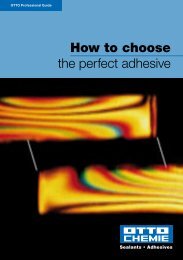
![[PDF] Sikaflex Floor PDS - Sika UK](https://img.yumpu.com/44159019/1/184x260/pdf-sikaflex-floor-pds-sika-uk.jpg?quality=85)
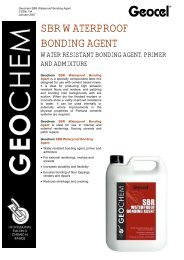
![[PDF] SikaBond TF plus N - Sika UK](https://img.yumpu.com/42388069/1/184x260/pdf-sikabond-tf-plus-n-sika-uk.jpg?quality=85)
![[PDF] Sikaflex -265 - Sika UK](https://img.yumpu.com/37723052/1/190x245/pdf-sikaflex-265-sika-uk.jpg?quality=85)
